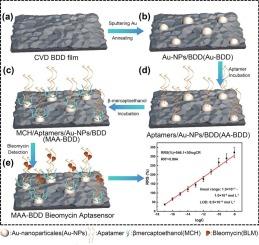硼掺杂金刚石与金纳米粒子偶联制备一种简单、高刚性的博来霉素适体传感器
IF 4.5
2区 化学
Q1 BIOCHEMISTRY & MOLECULAR BIOLOGY
引用次数: 0
摘要
博来霉素(bleomycin, BLM)是临床应用中必不可少的抗肿瘤药物,当其出现在生态环境中时,即使是微量浓度也会对人体健康产生不利影响。一种快速、简单、高效的微量BLM检测方法是人们所期望的,但传统的检测方法(如高效液相色谱法、酶联免疫吸附法等)通常需要昂贵的设备和复杂的过程,并且/或者运行时间长、重复性差。电化学生物传感器是一种快速、简便、灵敏、经济的检测BLM的方法,寻找合适的工作电极是实现高效检测的关键。结果本研究基于硼掺杂金刚石(BDD)电极,偶联金(Au)纳米粒子,设计了一种具有适配体、金纳米粒子和BDD膜协同组装的电化学适体传感器,用于BLM的灵敏和特异性检测。该传感器线性范围为1.0 × 10−17 ~ 1.0 × 10−8 mol L−1,检测限低至8.5 × 10−18 mol L−1。微量BLM血清的检测也显示出1.0 × 10−13-1.0 × 10−9 mol L−1的大范围。此外,干扰试验表明,在5个类似结构的干扰中,相对响应(RR, %)在- 4.1% ~ 6.4%之间,与第一天的100%相比,每天的RR在- 3.3% ~ 7.3%之间,证明了该传感器具有较高的稳定性、重复性和准确性。意义由β-巯基己醇(MCH)、适体体(Aptamers)、Au-NPs和BDD (MAA-BDD)组成的新型电化学痕量BLM检测适体传感器具有良好的灵敏度、特异性、刚性和可重复性,适合在各种环境下的痕量BLM检测中进一步实际应用。本文章由计算机程序翻译,如有差异,请以英文原文为准。

Boron-doped-diamond coupling with gold nanoparticles to prepare a simple and highly rigid aptasensor for detection of bleomycin
Background
Bleomycin (BLM), an essential antitumour medication in clinical applications, has detrimental effects on human health when it appears in an ecological environment, even at trace concentrations. It is desirable to detect trace amounts of BLM by a fast, simple, and efficient method, however, the traditional technologies (e.g., high-performance liquid chromatography, enzyme-linked immunosorbent assay, etc.) generally require expensive equipment and a complicated process, and/or have the disadvantages of long-time running times and poor repeatability. Electrochemical biosensors have been proposed as a fast, easy, sensitive, and cost-effective method for the detection of BLM, and finding a suitable work electrode plays a crucial role in realizing highly performance detection.
Results
In this work, based on a boron-doped diamond (BDD) electrode, coupling with gold (Au) nanoparticles, we design an electrochemical aptasensor for sensitive and specific detection of BLM, featuring a synergistic assembly of aptamers, Au nanoparticles, and BDD film. The BLM aptasensor presents a wide linear range in 1.0 × 10−17-1.0 × 10−8 mol L−1, and achieves a limit of detection as low as 8.5 × 10−18 mol L−1. The examinations of trace BLM serum also present a large region of 1.0 × 10−13-1.0 × 10−9 mol L−1. Besides, the interfering tests exibit that the relative responses (RR, %) are ranged from −4.1 % to 6.4 % in five similar structure interfer, and the daily RRs varies between between −3.3 % and 7.3 % in comparison to the 100 % for the first day, which domenstrating the high stability and repeatability and accuracy of the aptasensor.
Significance
The innovative aptasensor consisting of β-mercaptohexanol (MCH), Aptamers, Au-NPs, and BDD (MAA-BDD) for the electrochemical detection of trace BLM is of excellent sensitivity, specificity, rigidity, and repeatability, which is suitable for further practical applications on trace BLM detection in various environments.
求助全文
通过发布文献求助,成功后即可免费获取论文全文。
去求助
来源期刊

Bioelectrochemistry
生物-电化学
CiteScore
9.10
自引率
6.00%
发文量
238
审稿时长
38 days
期刊介绍:
An International Journal Devoted to Electrochemical Aspects of Biology and Biological Aspects of Electrochemistry
Bioelectrochemistry is an international journal devoted to electrochemical principles in biology and biological aspects of electrochemistry. It publishes experimental and theoretical papers dealing with the electrochemical aspects of:
• Electrified interfaces (electric double layers, adsorption, electron transfer, protein electrochemistry, basic principles of biosensors, biosensor interfaces and bio-nanosensor design and construction.
• Electric and magnetic field effects (field-dependent processes, field interactions with molecules, intramolecular field effects, sensory systems for electric and magnetic fields, molecular and cellular mechanisms)
• Bioenergetics and signal transduction (energy conversion, photosynthetic and visual membranes)
• Biomembranes and model membranes (thermodynamics and mechanics, membrane transport, electroporation, fusion and insertion)
• Electrochemical applications in medicine and biotechnology (drug delivery and gene transfer to cells and tissues, iontophoresis, skin electroporation, injury and repair).
• Organization and use of arrays in-vitro and in-vivo, including as part of feedback control.
• Electrochemical interrogation of biofilms as generated by microorganisms and tissue reaction associated with medical implants.
 求助内容:
求助内容: 应助结果提醒方式:
应助结果提醒方式:


